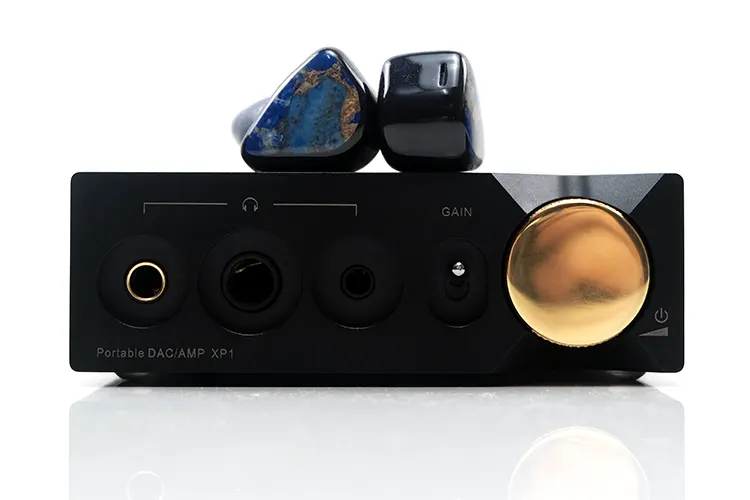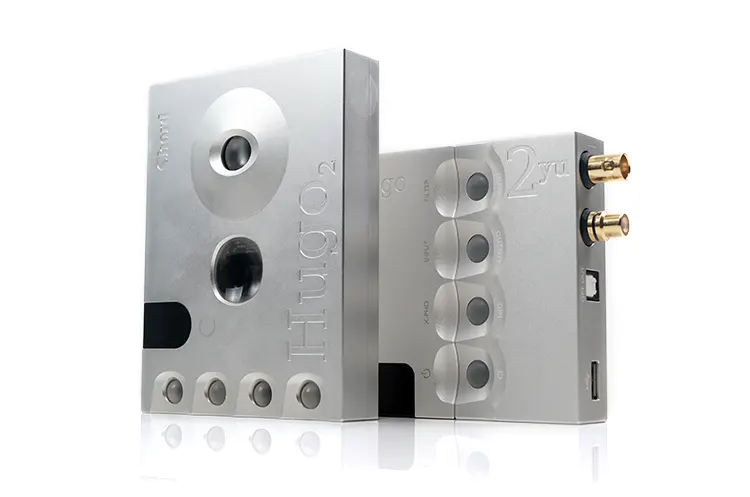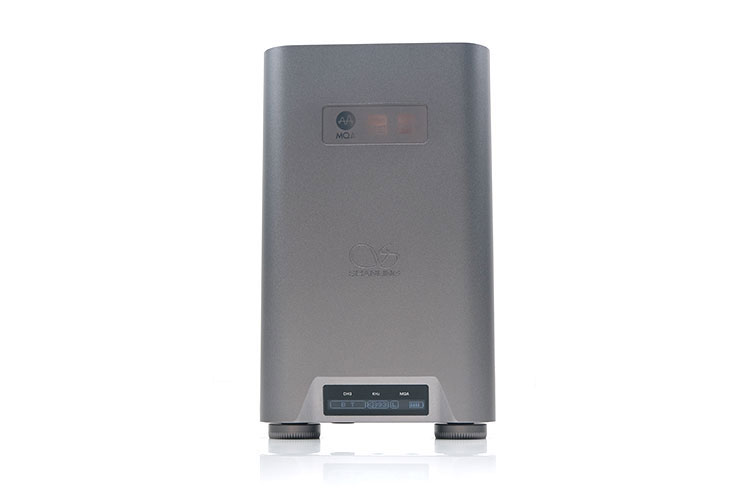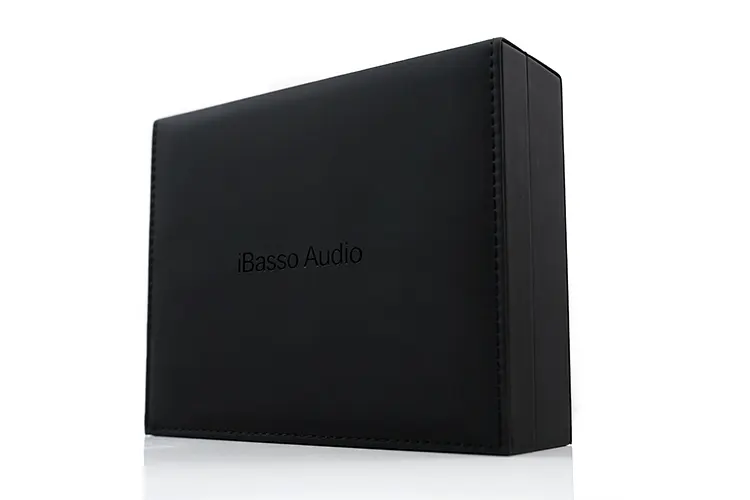Selected Comparisons
The following comparisons to the iBasso D16 Taipan were completed using a mix of the PMG Audio Apx, the DCA E3, and the iBasso SR3 (balanced and SE mode), and the D16 in USB-DAC mode from a Windows 10 PC using Roon.
ONIX Mystic XP1
The ONIX Mystic XP1 is a similar-priced integrated DAC/Amp launched in Q4 of 2023 and recently reviewed by me in Q2 of 2024.
Technical
From a narrow point of view, the D16 and the XP1 are balanced portable DAC/Amps with OTG and USB-DAC digital audio capability as well as the ability to split charging from data with dual USB-C I/O.
You can throw in two tiny screens into the mix but the XP1’s retro-styled OLED panel might look cooler but it is tiny compared to the 1.3” OLED of the D16.
The real differences start with the topology and extend into the user case scenarios each company has envisaged for their product. The D16 is wholly discreet, from the PWM-DAC inside to the Super Class A headphone amplifier, it’s 100% under the control of iBasso from an engineering perspective.
The Mystic XP1 uses a high-end delta-sigma dual AKM AK499EQ+AK4191EQ DAC and is equally capable decoding-wise at up to DSD512 natively and 32BIT/768kHz PCM. However, as with most Delta Sigma chipsets, it creates a slightly different timbre and is technically off-the-shelf and more limited.
ONIX also uses a TPA6120A2 opamp for the XP1 headphone amplifier which, whilst not discrete, is one of the better ones. The power is excellent at 812mW into a 32Ω load when AC-powered and from 750mW to 2360mW into the same load using the balanced output.
Without the unique M-power setup, the XP1’s maximum 750mW output is not as powerful as the D16’s super Class A 1125mW rating. Also, the output impedance of up to 6.6Ω balanced makes impedance-sensitive IEM matching trickier.
The ace up the XP1’s sleeve is its local TF playback and BT connection allowing you to integrate media playback locally via the Shanling Eddict app. That creates a pseudo-DAP of sorts, one that I find very useful at times.
Design
The drawback of the XP1 is that it’s a beast of a portable amplifier and easily the biggest of the 4 compared here in this review. It is a stylish amplifier, perhaps more so than the rather retro-build quality of the D16 but it is more transportable than portable IMHO.
The D16 is no shrinking violet either but it is so much lighter at 312g compared to 583g and from a personal perspective I appreciate the slightly softer curving of the housing.
The XP1 has some sharp edges here and there that can be uncomfortable when handling. There is no external leather case for it that I am aware of.
As portable DAC/Amps, they have plenty in common. Both have 4.4mm and 3.5mm PO on the front panel, though the XP1 has an additional 6.35mm which Sennheiser HD series headphone users might find appealing.
Dual gain is mechanical on XP1 and software-controlled or more granular (DAC and amplifier independent) on the D16. Both have SPDIF input with the XP1 throwing in a traditional AUX input below it on the rear panel.
The XP1 has a line out but it is only 4.4mm balanced at the rear with a pre-out function. The D16 has more flexibility here by offering SE and balanced LO via dual functionality on its front panel ports.
There is more granular control for power levels on the rear panel of the XP1. If you want that 2.4W balanced output power you need its accompanying DC 12V power supply but you can also opt to switch the power levels between IEMs and headphones with its ear/head switch.
Performance
I tested the PMG Audio Apx and the DCA E3 via their respective balanced outputs with both set in high gain and the Mystic XP1 in headphone mode. I would pick the Mystic XP1 for the E3 and the D16 for the Apx.
There are several reasons for that but the primary focus is on the meatiness of the XP1 lows through to the lower mids and the vocal focus. A secondary upper mids aspect from the D16 teases out better percussion emphasis and detail but this is more track-specific.
The Mystic XP1 has a fleshier weightier sub-bass presence and a prolonged bass shelf with more warmth traveling into the lower-mids with the paired gear. The D16 sounds more analog throughout but the emphasis on the lows is more linear and neutral in coloration and weight.
The D16 star power is through the mids with a vibrant and immediate vocal focus compared to the more laid-back vocal presence and timbre from the Mystic XP1. It sounds beautiful with the Apx pairing.
That means the Mystic XP1 is more lows-to-mids driven whereas the D16 is more mids-to-upper-mids driven. This works better on the more relaxed and spacious nature of the Apx mids but doesn’t mix quite as well with the more mid-forward nature of the E3 pairing with some tracks sounding slightly brighter.
The D16 has more upper-mid percussion sparkle on the E3 pairing. In comparison, the richer and warmer tonal qualities of the Mystic Xp1 flesh out the E3 lows a bit more creating a smoother sound.
Vocals also have a more relaxed tone, which is great for the E3/Mystic XP1 pairing but a bit dark and not as vibrant on the Apx where the D16 excels.
Chord Electronics Hugo 2
The Chord Electronics Hugo 2 can almost be considered a classic given it debuted in 2017 and won our Top Gear Best Portable DAC/Amp for that year. It still has many class-leading DAC/Amp features in 2024.
Technical
Of all the compared models to the D16 Taipan, the Hugo 2 is the portable amp/DAC with the closest DAC and headphone amplification design approach.
Both DACs topologies are PWM DACs or pulse width modulation in FIR mode with an FPGA digital bridge. iBasso doesn’t mention the chipset for the D16’s FPGA Master 2.0 but we know the Hugo 2 uses a Xilinx Artix 7.
Both units use an in-house developed algorithm for converting incoming digital signal shaping and conversion to PWM signals before sending them to their respective discrete PWM-DACs.
Neither company places the same focus on the strengths of their DAC format with Chord heavily spotlighting the tap length using a 10-element Pulse Array design and the D16 being pushed as having a great magnitude of PWM-DAC arrays at up to 128 in FIR mode compared to the Hugo 2’s 20.
For the consumer, the bottom line is a similar decoding capability up to PCM 768kHz/32-bit and native DSD512. Neither units handle MQA hardware rendering.
Both offer coaxial and optical inputs at 24BIT/192kHZ for optical and 32BIT/768kHz for coaxial. The Hugo 2 also has BT aptX, but it’s not something to shout about unless you are using 2Go.
The two amps have Class A amplification though the Hugo 2 is single-ended only. That has been a Chord design principle for a long time and you will not see a balanced PO on any of their headphone-related gear.
On a single-ended 32Ω load, the Hugo 2 is capable of 740mW which is more than the 640mW 16Ω benchmark of the D16 if we do the math for a similar load. However, it is less than D16’s balanced output maximum rating of 1125mW so the option for more power is there.
Design
The Hugo 2 aesthetics are more striking with a better build quality than the D16 but not necessarily the more intuitive unit for everyday use.
Its orb menu and volume system create steep learning curves with color codes and not one that sticks in the mind for any length of time unless you use it daily. I much prefer the simpler D16 OLED display and multifunction dial system.
I get the orbs are very durable though and they have been through thick and thin without so much as a scratch in the last 7 years in our office here.
The PO/LO layout relative to the main orb control system on the Hugo 2 has always been a bit strange for portable use. The PO and LO are on the opposite side of the main controls making it difficult to see your battery/filter status or control input options whilst using headphones.
The overall I/O split on the Hugo 2 is more what I would want for a desktop DAC feeding an amplifier than a portable carry device. The D16 has a more logical portable device layout with main controls and PO to the front and digital input on the rear panel including charging.
As mentioned, no balanced PO on the Hugo 2, just a 6.35mm and 3.5mm output with dual RCA for its lineout. If you want balanced for headphones or IEMs then the D16 is the better option.
One indirect plus of the Hugo 2 is its modular design. You can attach Chord’s wireless streaming 2go module and create a portable all-in-one device with app integration. It’s a fairly modern approach which the D16 lacks though the Chord Go Figure app is a pain to use.
Performance
Listening to these two with iBasso’s SR3 reminds me of my previous reviews comparing R-2R DACs with delta-sigma alternatives.
Despite both having PWM-DACs the Hugo 2 sound feels like an incredible version of delta-sigma; super polished, with perfect harmonic balance and decay length combined with speed and resolution.
The D16 moves closer to the 1BIT or R-2R sound with a grittier texture and a slightly smoother more relaxed upper-treble presence on the SR3. It creates an impression of music that is less mixed, less oversampled in a way, rawer and true to life, imperfections be damned.
Arguably more analog, not as nippy, and with a bit more warmth, this pairing is less about perfection and more about character with a more interesting vocal texture but perhaps less ‘resolution gymnastics’ to coin a phrase.
The soundstage is also an interesting contrast. The clarity perhaps favors the speed and precision of the Hugo and it does have a wider staging dimension and to a certain extent a busier set of highs on the SR3.
However, I found the D16/SR3 pairing deeper sounding. I do not mean bass power as both are fairly neutral in that regard but rather the perceived space from front to back of the stage, particularly through the mids, seemed magnified and roomier with the D16.
Shanling H7
The Shanling H7 was launched in early 2023 with several innovative features that arguably reinvigorated what was interpreted as a portable amp/DAC in the modern era. It was also our Top Gear 2023 Best Portable Amp/DAC award winner.
Technical
In some ways, the H7 is a junior ONIX Mystic XP1 with its single delta-sigma AKM AK499EQ+AK4191EQ DAC rather than dual and up to 1.3W balanced output power into a 32Ω load. That is almost half the XP1’s AC-power mode but more or less on par with the D16 Taipan’s balanced output capability.
There is nothing inside the H7 that is even close to being called discrete, with its similar IC TPA6120A2 headphone amplification topology, OPA2211, and MUSES8920.
The D16’s PWM-DAC and super Class A headphone amplifier with its dual DAC and analog headphone amplification is a much more elegant design with a lower noise floor. However, the output impedance of the H7 is pleasingly sub 1Ω, unlike the XP1.
Both DACs can decode up to DSD512, PCM 32BIT/768kHz, and the H7 also offers MQA 8X, though it is debatable how relevant that is in 2024.
The D16 SPDIF has a higher decoding at PCM 768kHz/DoP256 coaxial and PCM 192kHz/24BIT optical compared to the H7’s maximum of 192kHz/24BIT for coaxial and 96kHz/24BIT for optical.
The H7 does have wireless with BT so you can add LDAC 24BIT/96kHz to its decoding capability. However, the real value of wireless is the Eddict app integration combined with its TF card local playback capability, a feature similar to the XP1.
One of the more unique attributes of the H7 shared by the Hugo 2 is its dual RCA line-out on the rear panel. This is a throwback to classic HIFI connections which some might find quite useful in a home setup.
Design
The H7 is the more compact of the two units and dare I say it the more modern and comfortable to hold in the hand with its curved hip-flask-type aluminum chassis.
Despite the slight reduction in width, it’s still as long as the D16 and weighs a little more at 352.5 g compared to 312g so to be honest there is not a huge amount of difference in their portability.
The biggest physical difference is their respective information panels with the H7 much too small to be of much use other than a quick status check for volume, gain, and battery life.
The split in operation between the two multifunction dials on the front panel for navigation is also a bit fiddly, more so than the bigger OLED display and more intuitive single small dial on the D16.
You are better off using the H7 via the Eddict app where, depending on your phone size, you get a lot more screen real estate, some useful controls, and local media browsing and playback controls via the rear mount TF card system.
Both offer balanced and SE PO but like the XP1, the H7 also offers a 6.35mm PO that is missing on the D16. Again, this is something I think Sennheiser HD series headphone users will particularly appreciate. One drawback of the H7 is the lack of a balanced lineout.
The rear of the H7 has a similar DAC and charging USB-C socket split and a digital in with that dual RCA output the main differentiator between its rear panel and the D16 rear panel.
Performance
For this comparison, I switched to the local TF card on the H7 and OTG using a Samsung S23 Ultra connected to the D16 Taipan. I consider the TF performance on the H7 superior to its USB-DAC. I also used the balanced output of both with the PMG Audio Apx.
The H7 is a more relaxed-sounding delta-sigma tuning with a slight bit of polish to the note texture and is not on the same level as the D16 in terms of detail within that note texture either.
The difference in the life-like quality of instruments is stark. Arguably, the H7 sounds like an interpretation of an instrument in the studio post-mix. Whereas with the D16, particularly through the mids with woodwind, it feels like you are listening to a live performance.
Imaging is also quite different. The H7 is relaxed through the mids. Vocals are further from your ear compared to the D16 which is a factor in the perceived additional vibrancy in the mids from the D16.
Despite the more upfront vocal delivery the space and instrumental separation are more holographic-sounding from the D16. Vocals and instrumental separation on the H7 are not quite as distinct giving it a comparatively wide but flatter staging quality.
The last strongly noticeable trait is the fundamental frequency of instruments throughout the FR. Despite what I would define as a relatively neutral or linear bass response, the D16 notes have a firmer quality or better fundamental frequency.
The H7 sounds comparatively attenuated giving lower-pitching notes a softer underbelly, sounding almost wispy and ethereal in comparison.
Unless you deeply desire the weighty ONIX Mystic XP1 bass performance, the D16 Taipan is the next logical upgrade for H7 owners purely on sound performance.
My Verdict
The iBasso D16 Taipan is an outstanding return to form for one of the original pioneers of the portable DAC/amplifier market with its beautifully textured analog tuning and flexibility for a wide range of modern IEMs and headphones.
In some ways, I hope the company takes the new PWM-DAC approach and tries to work it into their DAPs and dongles if possible. It is the kind of inviting natural-sounding sound signature I was hoping iBasso would someday try as opposed to another delta-sigma offering.
They have been on top of the discrete amplification game for some years now so pulling the DAC design in-house gives them a massive amount of control to create almost any type of sound or performance they want.
It’s still a regulation black box though, perhaps something can be done there over time to modernize the casing and I do note that for pure power other portable offerings deliver more.
Still, for IEM lovers the D16 is a truly excellent performer and at least for 2024, it is one of the class leaders in terms of just how good a portable amp/DAC can or should sound.
iBasso D16 Taipan Technical Specifications
4.4mm LO
- Output Level: 3.3Vrms (DAC Low Gain) 4Vrms (DAC High Gain)
- THD+N: -120.4dB(0.000095%)@1kHz AES17-20K A-wt
- DNR: 123dB AES17-20K A-wt
- SNR: 123dB AES17-20K A-wt
- Crosstalk: 135dB
- Frequency Response: 15Hz-40kHz +/-1dB
3.5mm LO
- Output Level: 1.65Vrms (DAC Low Gain) 2Vrms (DAC High Gain)
- THD+N: -118dB(0.00012%)@1KHz
- AES17-20K A-wt
- DNR: 120dB AES17-20K A-wt
- SNR: 120dB AES17-20K A-wt
- Crosstalk: 133dB
- Frequency Response: 15Hz-40kHz +/-1dB
4.4mm PO
- Output Level: 4.2Vrms (AMP L Gain + DAC H gain)
- 6.8Vrms (AMP H Gain + DAC H gain)
- Output Power: 1125mW+1125mW@32Q
- THD+N<0.5% THD+N: -117dB(0.00014%)@1KHz
- AES17-20K A-wt 6000 Load
- DNR: 123dB AES17-20K A-wt
- SNR: 123dB AES17-20K A-wt
- Crosstalk: 131dB
- Frequency Response: 15Hz-40kHz +/-1dB
3.5mm PO
- Output level:
- 2.1Vrms (AMP L gain + DAC H gain)
- 3.4Vrms (AMP H gain + DAC H gain)
- Output Power:640mW+640mW@16ΩTHD+N<0.5%
- THD+N:-114dB(0.00019%)@1kHz AES17-20K A-wt 600Ω Load
- DNR:118dB AES17-20K A-wt
- SNR:118dB AES17-20K A-wt
- Crosstalk:130dB
- Frequency response:15Hz-40kHz +/-1dB
Input interface
- USB-C input supports PCM768kHz/DSD512 3.5mm
- Coaxial input supports PCM768kHz/DoP256 3.5 mm
- Optical input supports PCM192kHz/DoP128
Output interfaces
- 4.4 mm balanced output
- 3.5 mm output (single-ended)
- 4.4 mm LO output
- 3.5 mm LO output
- Charging interface: USB-C (Charge), supports 5V/2A and QC3.0 fast charging
- Size: 139mm*82mm*28mm Weight: 312g






